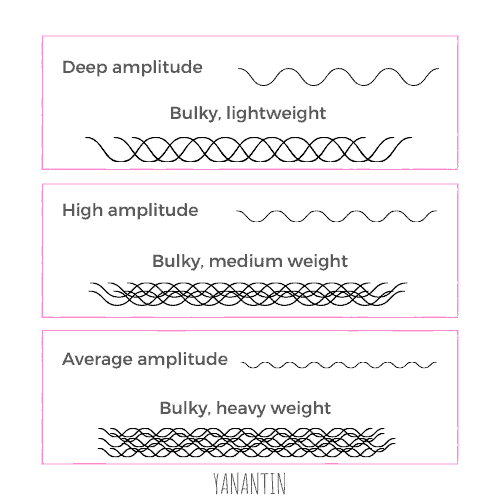I often read that alpaca wool is better than sheep’s wool in many aspects. One of the claims is that it is specifically lighter than wool. But I’ve never found any real evidence that supports this claim. So, now I wonder… Is alpaca wool really lighter than sheep’s wool?
can i buy generic Lyrica Comparing alpaca and regular wool from a similar yarn category shows that alpaca wool is heavier than normal wool. Baby alpaca has a similar weight as regular wool, whereas (superfine) merino wool (also sheep) is lighter than all three. However, alpaca wool has a better warmth-to-weight ratio.
The fiber texture of alpaca wool is very different compared to sheep wool, so when it comes to the weight of an actual garment, the one using alpaca wool could end up being lighter.
So, let’s see how that works.
How Much Does Alpaca Wool Weigh? (Compared to Other Fibers)
In order to compare the weight of alpaca wool with other types of fibers, it is important to look at one universal measurement. I choose to compare 50 grams of DK yarn (Double Knitting), DK being possibly the most common and default weight for knitting.
Yarn is always sold with the length of the yarn given (either in meters or yards). So, if you have the weight and the length, you can calculate how much the yarn weighs per meter or yard. This tells you that if the yarn is longer, it is lighter.
This means that if you were to knit a garment using a DK yarn, the garment made with the “longer” yarn would be lighter (assuming you use the same needle size, stitch, pattern, gauge, etc.) because you need less balls of yarn. Makes sense?
| tenably Category | Weight (grams) | Weight (ounces) | Length (meters) | Length (yards) |
|---|---|---|---|---|
| Medium Alpaca | 50 grams | 1.76 oz. | 100 m | 110 yards |
| Baby Alpaca | 50 grams | 1.76 oz. | 112 m | 122 yards |
| Wool | 50 grams | 1.76 oz. | 112 m | 122 yards |
| Superfine Merino | 50 grams | 1.76 oz. | 116 m | 127 yards |
| Cotton | 50 grams | 1.76 oz. | 114 m | 125 yards |
| Acrylic | 50 grams | 1.76 oz. | 147.5 m | 161 yards |
| 50% Acrylic 50% Superfine Merino | 50 grams | 1.76 oz. | 125 m | 137 yards |
Let’s put this in “practice”: for a simple cardigan (size 40/42), you’d need 8 x 50 grams of wool. So…:
- If you were to use alpaca wool, that would mean you would use 800 meter of yarn (880 yards) to make the cardigan.
- Whereas with regular wool you’d have 896 meter of yarn (976 yards) available, but you only need the same amount, right!?
- This implies that you will either need to add an extra ball of 50 grams, to get to the same length, or you need one ball of 50 grams less when using regular sheep wool.
It is very unlikely that you will feel the difference of 50 grams less or more when you’re wearing a garment, but technically, alpaca wool should feel heavier than sheep wool.
So, when alpaca wool is used in a garment, more alpaca fiber is needed to create bulk. Alpaca wool has less bulky fibers (less fiber curvature), which means that its yarn is less bulky. So, when used in a garment, alpaca wool is heavier because more yarn is needed to create bulk.

Bulky garments are normally lighter compared to non-bulky garments. When a garment is bulky, it means that there is a lot of air inside the garment (which creates the bulk), making it light, yet warm at the same time.
Bulk is created when a garment has a high crimp and deep amplitude. Alpaca wool is not known for its high crimp, but fibers like merino, are. So, you need much more alpaca fibers to create a similarly bulky yarn.
As you can see in the chart above, merino fibers are lighter, indeed.
Comparing Fibers Is Like Comparing Apples and Oranges!
There are a lot of variables between sheep and alpaca wool that influence the weight of a garment, and even international Alpaca Expert Cameron Holt couldn’t find much evidence whether or not alpaca wool is lighter or heavier than sheep wool.
Some of the other things to consider when comparing alpaca with other types of wool:
- Gauge of stitches
- Stitch type and size
- Double or single stranded
- Knitted vs. woven
- Type of garment
- Weight category of the yarn
Alpaca wool is often used for fine, delicate garments. Its fine fibers are still very strong (in fact, they are actually stronger than regular sheep wool because of their high staple length), which means that thinner yarn can be used to make sweaters, tops, cardigans, etc.
So, where does the claim come from that alpaca wool is lightweight? Well, probably because people who buy alpaca woolen products will end up not buying the chunky, bulky garments (they don’t even really exist with 100% alpaca wool!), but buying drapey, silky, fine garments instead.
And of course, when you wear those, they will feel super light!
And this is when another feature of alpaca wool comes into play: it’s warmth-to-weight ratio.
The Warmth-to-Weight Ratio of Alpaca Wool
One of the great features of alpaca wool is that it is warm, but unfortunately, it brings us to another alpaca myth: despite the claims that alpaca wool is warmer than sheep wool, there is little evidence to prove this.
There is one test done by Trevor Beuth of Kelly and Windsor suggests that:
“it takes less alpaca fibre than sheep’s wool to create the same level of warmth in quilts.”
Trevor Beuth of Kelly and Windsor
According to the data from their research, when used in an equal amount, regular sheep wool is less warm than alpaca wool (with 450 gsm, a quilt made with alpaca has a TOG rating of 7, whereas a quilt made with sheep wool only has a TOG rating of 6.5). (Referred to by Cameron Holt)
This could actually indicate that when alpaca wool is used in garments, a thinner yarn can be used to create a warm product. So, while it is tricky (dare I say impossible?) to compare garments this way, it would explain why many people think alpaca wool is lighter:
It is simply because they generally wear light, alpaca woolen items! Whereas sheep woolen products are generally thick and bulky and thus, in our minds they are heavy!
Alpaca Wool: Weight When Wet
Ever washed an alpaca woolen product? WOW! Alpaca wool gets really heavy when it is wet!
Alpaca wool can absorb up to 30% of its dry body weight in water without feeling clammy. After that, it can absorb even a lot more water, but of course, it will feel wet.
What does this mean? Alpaca wool has this amazing feature of being very water-resistant. Its fibers repel water before it gets absorbed. When water gets absorbed, it absorbs a lot of water without you even noticing it.
Although, this would increase the weight, right!?
- Let’s say you’re wearing an alpaca woolen hat that weighs a 100 grams (0.22 lbs.). If you add another 30% of water weight that means it will now weigh 130 grams (0.28 lbs.), but it still feels dry!
Now why is this important for the weight, again?
It makes wool incredibly PERFECT for high intensity activities or for wearing in humid environments where you need to wear insulating clothes. Materials like cotton will instantly feel wet, for example, but wool will not, which is way more comfortable to wear (even safer, according to Section Hiker).
And on top of that, cotton and synthetic fibers lose their insulating properties when wet, whereas wool still rocks at that when wet!
It’s not necessarily the weight that matters, it is the combination of weight vs. water absorption vs. warmth vs. insulating properties vs. touch that count.


